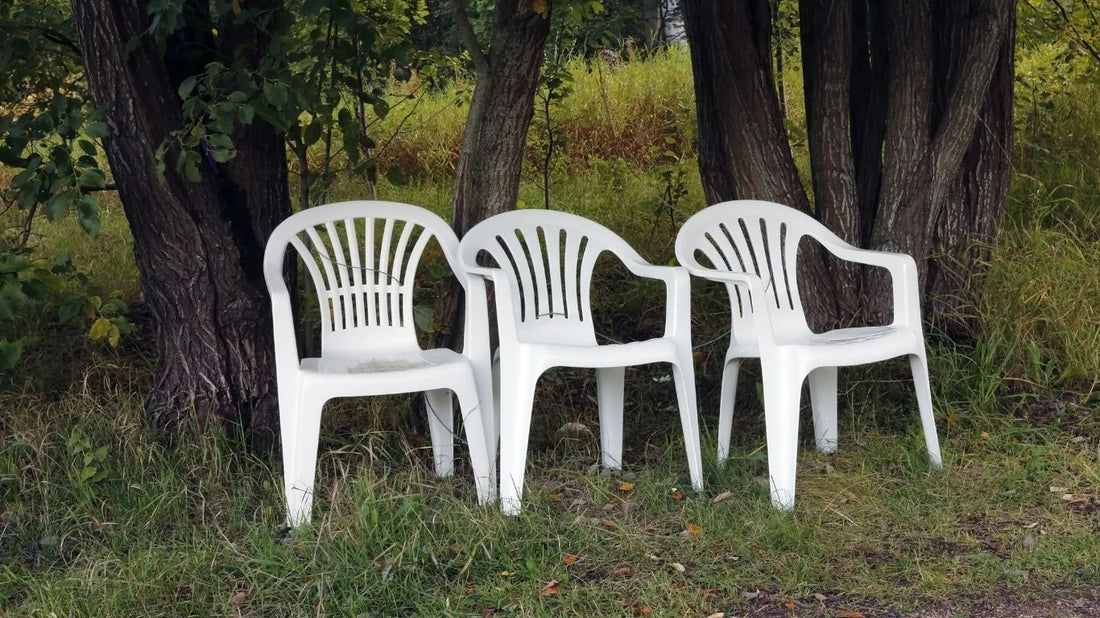
How to Clean Plastic Chairs: Importance & Tips
Share
Plastic chairs are an essential part of many households, patios, and gardens. Their affordability, lightweight nature, and durability, especially for outdoor use, make them a popular choice for everything from casual seating to events and gatherings. Plastic chairs are versatile and can withstand weather conditions better than most furniture options, making them ideal for both indoor and outdoor settings.
However, with their widespread use comes a common problem: plastic chairs can get dirty, discolored, and stained easily. This issue is especially true for white plastic chairs, which tend to show every speck of dirt, pollen, or food stain. Whether exposed to the sun, rain, or spills, your plastic chairs might lose their gleam quickly.
In this blog, we’ll not only show you how to clean plastic chairs effectively, but we’ll also explain why regular cleaning is necessary, especially for white plastic chairs, and provide easy-to-follow ways to clean plastic chairs. These tips will ensure that your chairs stay spotless, functional, and long-lasting.
Why Regular Cleaning of Plastic Chairs Matters?
1. Hygiene & Health
Plastic chairs, particularly outdoor ones, can accumulate dirt, debris, and bacteria over time. If left uncleaned, these chairs become breeding grounds for mold, mildew, and even pests like ants or spiders. This is especially important for chairs used in dining areas or children’s play zones where cleanliness is crucial.
Moreover, outdoor chairs are often exposed to the elements, making them more prone to dirt from dust storms, pollen, or even animal waste. Regular cleaning not only ensures a safer environment but also reduces potential health risks associated with allergens, germs, or bacteria.
2. Longevity of Furniture
While plastic is durable, accumulated dirt and grime can deteriorate its quality and cause discoloration or cracks over time. Regular cleaning prevents wear and tear, helping your chairs last longer and continue to perform as they should. Not only does it maintain the physical integrity of your chairs, but it also protects the investment you made in them.
3. Aesthetic Appeal and Stain Prevention
Over time, dirt, food spills, and weathering can cause stains that are difficult to remove. Preventing stains before they set is one of the primary reasons to keep your plastic chairs clean. Routine cleaning keeps your chairs looking new, ensuring they always enhance the aesthetics of your space. Additionally, clean plastic chairs are far more appealing when hosting guests or using them for outdoor activities.
4. Preventing Mold, Mildew, and Hard Water Stains
Outdoor plastic chairs are particularly susceptible to mildew and mold due to moisture exposure. Mold can grow in the tiny crevices of your chairs, especially if they remain wet for prolonged periods. If you don’t clean plastic chairs regularly, hard water stains can also appear, making them unsightly and difficult to remove.
What You’ll Need to Clean Plastic Chairs?
To make sure you clean your plastic chairs efficiently, you'll need a few basic cleaning supplies:
- Mild dish soap: Works well for general cleaning without damaging the surface.
- Baking soda: An abrasive cleaner that helps remove stubborn stains.
- White vinegar: A natural disinfectant that’s effective at tackling mildew and grime.
- Soft-bristle brush: For scrubbing hard-to-reach areas without causing scratches.
- Sponge: For gentle surface cleaning.
- Bucket: To mix cleaning solutions.
- Hose: For rinsing off cleaning solutions (ideal for outdoor chairs).
- Microfiber cloths: To dry your chairs without leaving lint behind.
- Optional bleach: If your plastic chairs are white and need a deeper cleaning (use cautiously).
With these basic supplies, you can clean plastic chairs of all types, whether they’re white, colored, or designed for outdoor use.
Step-by-Step Guide: How to Clean Plastic Chairs?
1. Basic Cleaning for Everyday Dirt
For everyday dirt and grime, a simple cleaning routine is usually sufficient:
- Mix warm water and dish soap in a bucket.
- Use a soft sponge or a soft-bristle brush to scrub the surface of the chair.
- Focus on the arms, legs, and seat areas that come in contact with dirt more frequently.
- Rinse with a hose or clean water to remove all soap residue.
-
Wipe with a microfiber cloth to dry.
This basic cleaning method works wonders for regular upkeep. It’s quick, easy, and prevents buildup that can lead to more significant problems down the road.
2. Deep Cleaning for Stubborn Stains or Discoloration
If your chairs have visible stains or have started to discolor, it’s time for a more thorough cleaning. Here are a few deep cleaning methods:
Baking Soda Paste Method
- Make a paste by mixing baking soda with water.
- Apply the paste to the stains or discolored spots.
- Let it sit for about 10 minutes, then scrub gently with a brush.
- Rinse thoroughly.
This is an excellent way to clean plastic chairs when stains are stubborn or set in.
Vinegar Spray for Mildew
- Mix equal parts of white vinegar and water in a spray bottle.
- Spray the solution directly onto areas affected by mildew or mold.
- Let it sit for 10-15 minutes before scrubbing with a brush.
- Rinse with water.
Vinegar is an effective, natural solution for dealing with mildew and musty odors on outdoor plastic chairs.
Bleach Soak for White Chairs
- If your white chairs are heavily stained, mix 1/4 cup bleach with 1 gallon of water.
- Soak a cloth in the bleach solution and drape it over the stained areas.
- Let it sit for 10-20 minutes (watch carefully to avoid damage).
- Rinse thoroughly with water to remove all bleach residue.
Caution: Always wear gloves, work in a well-ventilated area, and test this method on a small area first.
3. Power Washing for Outdoor Plastic Chairs
For large outdoor plastic chairs, a power washer can make cleaning faster and more effective. Here's how:
- Set your power washer to a low or medium pressure to avoid damaging the plastic.
- Hold the nozzle about 12 inches away from the chair’s surface.
- Start from the top and work your way down, spraying in long, steady motions.
- Focus on areas that gather the most dirt, such as under the seat or along the legs.
Using a power washer is a great option if you need to clean a large number of outdoor chairs quickly and thoroughly.
Pro Tips for Cleaning White Plastic Chairs
White plastic chairs are prone to showing dirt and stains, so here are some extra tips for maintaining their bright look:
- Avoid harsh scrubbers: Steel wool or rough brushes can scratch the surface, making it harder to clean in the future.
- Always dry the chairs properly: After cleaning, dry them with a microfiber cloth to avoid watermarks or mildew growth.
-
Test solutions: Before applying any cleaning solution, test it on an inconspicuous area to ensure it won’t cause damage or discoloration.
Preventive Care and Maintenance
To keep your plastic chairs looking clean for longer periods, follow these simple tips:
- Store chairs indoors or use covers when not in use. This prevents exposure to the sun and weather that causes fading and grime buildup.
- Clean spills immediately. This prevents stains from setting into the plastic.
-
Consider using a UV-protective spray. These sprays can help shield your plastic furniture from sun damage and prevent discoloration.
Eco-Friendly Cleaning Alternatives
If you prefer natural cleaning solutions, there are plenty of eco-friendly options:
- Lemon juice: A natural bleach alternative that works wonders on tough stains.
- Vinegar: A versatile and eco-friendly cleaner that tackles mildew, grime, and odors.
- Homemade cleaning solutions: Mix vinegar, water, and a small amount of dish soap to create a gentle yet effective cleaner.
Using natural, DIY solutions not only save you money but also reduces your environmental footprint.
Conclusion
Now that you know the best ways to clean plastic chairs, maintaining your furniture has never been easier. Whether it’s everyday dirt, stubborn stains, or heavy mildew buildup, the methods outlined in this blog will help keep your plastic chairs clean and in great condition.
By incorporating regular cleaning into your routine, using proper care methods, and opting for eco-friendly solutions, your chairs will remain a functional and attractive part of your home for years to come.









